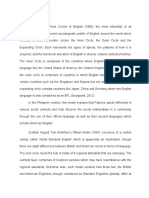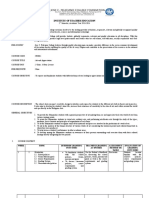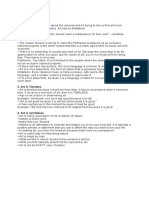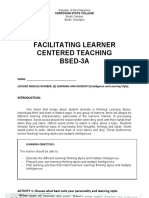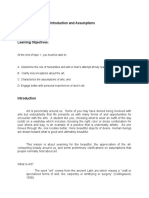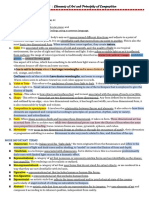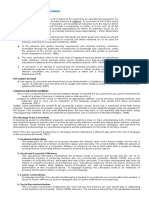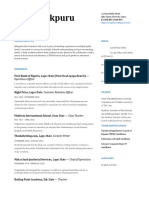Art Appreciation - Revised 2013
Art Appreciation - Revised 2013
Uploaded by
ichu73Copyright:
Available Formats
Art Appreciation - Revised 2013
Art Appreciation - Revised 2013
Uploaded by
ichu73Original Description:
Copyright
Available Formats
Share this document
Did you find this document useful?
Is this content inappropriate?
Copyright:
Available Formats
Art Appreciation - Revised 2013
Art Appreciation - Revised 2013
Uploaded by
ichu73Copyright:
Available Formats
DOCUMENT: SYLLABUS DOCUMENT NO.
: CEAS-SYL-____ DATE OF EFFECTIVITY: JUNE 17, 2013
SUBJECT: Page __ of 7 ART APPRECIATION SUPERSEDES: CEAS-SYL-026 DATED: NOVEMBER 08, 2012 ISSUED TO: (COPIES) CENTRAL FILE VPAA OFFICE DEAN-CEAS CEAS FACULTY ACCREDITATION ROOM
COURSE DESCRIPTION The course is a critical exploration of various art forms as products of creative imagination in dynamic interaction with societies and cultures. It aims to make students develop critical and analytical sensitivity towards higher aesthetic sensibility. It also aims to develop students deeper awareness and understanding towards various arts in relation with their socio-historical and cultural context; and see its relevance to their everyday lives. PRE-PREQUISITE None
GENERAL OBJECTIVES At the end of the course, the students shall be able to: Cognitive: 1. Explain the basic concepts and principles in art appreciation from art production to art criticism; 2. Identify and critically analyze the cultural inclination of arts in various societies and epochs; 3. Classify various art forms based on cultures where they came from and recognize interweaving aesthetics of such with our own ; Affective: 1. Appreciate various art works based on personal and formal form of analysis; 2. React with the revolutions that occurred in the arts vis--vis cultures and societies; 3. Exemplify deeper understanding of various arts and cultures through class activities and project; Psychomotor: 1. Participate in art activities which they may exalt their interpersonal and intrapersonal skills; 2. Contribute in the pedagogy of arts and humanities through activities performed in and out the classroom.
NU-ISO-001
ISO FORM
DOCUMENT: SYLLABUS DOCUMENT NO.: CEAS-SYL-____ DATE OF EFFECTIVITY: JUNE 17, 2013
SUBJECT: Page __ of 7 ART APPRECIATION SUPERSEDES: CEAS-SYL-026 DATED: NOVEMBER 08, 2012 ISSUED TO: (COPIES) CENTRAL FILE VPAA OFFICE DEAN-CEAS CEAS FACULTY ACCREDITATION ROOM
VALUES TO BE DEVELOPED 1. Trustworthiness 2. Self-discipline 3. Respect 4. Compassion 5. Industrious 6. Nationalism 7. Resilience 8. Artistry 9. Creativity 10. Multi-Culturalism
CREDIT: 3 Units TIME ALLOTMENT: 3 hours lecture every week
COURSE REQUIREMENTS 1. Regular class attendance; reading of assigned text and other materials 2. Active participation in oral activities, discussions, and group dynamics 3. Art production activities which may vary based on the instructors preference 4. Quizzes and three (3) major exams 5. Reaction/ Critique Paper for: a) museum visit, b) film viewing, c) theatrical play viewing 6. Attending an Art Exhibition and/ or Art Performance such as Theatrical Play COURSE EVALUATION GRADING SYSTEM Class Standing Requirement - Quizzes 20% - Attendance 5% - Home/Classwork 20% - Recitation 15% Periodic/Major Exam Total per term NU-ISO-001 60% Division of Final Grade Prelim 30% Midterm 30% Final 40% TOTAL 100% Scoring Rubrics for Critique Papers: Presentation of Data (depth of research) Analysis (utilization of theories) Citation of Sources (in-text and bibliography) Grammar and Sentence Construction Total 35% 35% 20% 10% 100%
40% 100% ISO FORM
DOCUMENT: SYLLABUS DOCUMENT NO.: CEAS-SYL-____ DATE OF EFFECTIVITY: JUNE 17, 2013
SUBJECT: Page __ of 7 ART APPRECIATION SUPERSEDES: CEAS-SYL-026 DATED: NOVEMBER 08, 2012 ISSUED TO: (COPIES) CENTRAL FILE VPAA OFFICE DEAN-CEAS CEAS FACULTY ACCREDITATION ROOM
COURSE CONTENTS PART I. INTRODUCTION TO ARTS AND HUMANITIES WEEK # 13 SPECIFIC OBJECTIVE At the end of this module, the students shall be able to: Identify the basic principles about art production and criticism React to various perspectives toward arts and humanities Western and non- Western notions Demonstrate basic art appreciation ideologies through formal and informal analyses and discussions TOPIC What is Art? Basic Elements in Art Dichotomy between Western and Non- Western Art Alice Guillermos Four Planes of Analysis ACTIVITY Discuss syllabus and course outline, class requirements, class rules, and class expectations Interactive discussion Classroom discussion regarding the basic theories that is needed for art appreciation Sharing/ discussion INSTRUCTIONAL MATERIAL Course Syllabus Reading Material PPT Presentations EVALUATIVE MEASURE Recitation reflecting on both personal and formal forms of art appreciation Art criticism drills where students may apply the basic planes of analysis in the art realm Quizzes which may gear towards deeper understanding with various elements and principles
PART II. PAINTING 46 At the end of this module, the students shall be able to: Name notable painters, NU-ISO-001 Basic Principles and Elements of Painting Art Movements from Classical to ISO FORM Discussion regarding the basic principles and elements in painting Textbook PPT Presentations Interactive discussion which may reflect as an informal recitation
DOCUMENT: SYLLABUS DOCUMENT NO.: CEAS-SYL-____ DATE OF EFFECTIVITY: JUNE 17, 2013
SUBJECT: Page __ of 7 ART APPRECIATION SUPERSEDES: CEAS-SYL-026 DATED: NOVEMBER 08, 2012 ISSUED TO: (COPIES) CENTRAL FILE VPAA OFFICE DEAN-CEAS CEAS FACULTY ACCREDITATION ROOM
paintings, and art movements in the history Criticize artworks utilizing the theories learned in class Create paintings or drawings and reflect on the crucial role art works play in social and cultural context
Modernism Philippine paintings vis--vis Foreign paintings
Explain notable painters and paintings in both Western and NonWestern realm Provide art trivia in class Art criticism and appreciation drills directed to various paintings shown in class
Slideshow Magazine and Newspaper Images Painting materials for hands- on activity
Interpreting artworks based on various context and perspectives Art production activity Prelim Examination
PART III. SCULPTURE 79 At the end of this module, the students shall be able to: Link the art movements discussed in part two with the departure of sculptural techniques in the history Note important sculptors in the history Criticize sculptures utilizing theories learned in class, reflecting it with both social and cultural context Experience actual art forms NU-ISO-001 ISO FORM Basic principles and elements of sculpture Sculptural techniques based on the period or origin of such sculptures (refer to part two of the syllabus for the art movements) Discuss various sculptural works within the Philippines Discussion regarding the basic principles and elements of sculpture relating it with the art movements discussed in part two Home works Provide art trivia in class Art criticism and appreciation drills Textbook PPT Presentations Slideshow Magazine and Newspaper Images Interactive discussion which may reflect as an informal recitation Interpreting artworks based on various context and perspectives Reaction or Critique Paper Museum Visit
DOCUMENT: SYLLABUS DOCUMENT NO.: CEAS-SYL-____ DATE OF EFFECTIVITY: JUNE 17, 2013
SUBJECT: Page __ of 7 ART APPRECIATION SUPERSEDES: CEAS-SYL-026 DATED: NOVEMBER 08, 2012 ISSUED TO: (COPIES) CENTRAL FILE VPAA OFFICE DEAN-CEAS CEAS FACULTY ACCREDITATION ROOM
through museum visit and be able to share realizations during class discussion
PART IV. ARCHITECTURE 10 12 At the end of this module, the students shall be able to: Note important architects, innovations, and techniques in the field of architecture Criticize architectural innovations in response with the art movements previously discussed Debate on Western and nonWestern architectures reflecting on the social, historical, and cultural context of such art works Basic principles and elements in architecture Architectural techniques and innovations Comparison between Western and non-Western architectures Philippine architectures such as the Bahay Kubo and Bahay na Bato Discussion reflecting with the principles, elements, techniques, and innovations Provide trivia in class Home works Art appreciation and criticism drills Debates integrating parts one, two, and three Textbook Online resources Newspaper/Magazine Articles PPT Presentation Film viewing fusing painting, sculpture, and architecture The Name of the Rose Interactive discussion which may reflect as an informal recitation Interpreting artworks based on various context and perspectives Art production activity Individual Report on any art form or the like Midterm Examination
PART V. MUSIC, THEATER ARTS, AND CINEMA
NU-ISO-001
ISO FORM
DOCUMENT: SYLLABUS DOCUMENT NO.: CEAS-SYL-____ DATE OF EFFECTIVITY: JUNE 17, 2013
SUBJECT: Page __ of 7 ART APPRECIATION SUPERSEDES: CEAS-SYL-026 DATED: NOVEMBER 08, 2012 ISSUED TO: (COPIES) CENTRAL FILE VPAA OFFICE DEAN-CEAS CEAS FACULTY ACCREDITATION ROOM
13 15
At the end of this module, the students shall be able to: Classify such art forms based on the basic principles, ideologies, and techniques Identify notable artists in these art fields Appreciate the social, cultural, and historical context of such art works Conduct research on a specific indigenous art practice and reflect on it through a reaction paper
Basic principles, elements, and structures in music, theater arts, and cinema Notable artists in the given art fields Comparison of such arts between cultures Indigenous art practices
Art appreciation and criticism drills Class group works
Textbook Online resources
Art production activities play/ role play Recitation
PPT Presentation Home works Audio Visual (Theater/ Play viewing) Film viewing Reaction/ Critique Paper
PART VI. TECHNOLOGY: MASS MEDIA AND HYPER MEDIA 16 18 At the end of this module, the students shall be able to: Explain how the arts can be perceived in the technological era Deepen understanding with regard to the role of arts in NU-ISO-001 Utilization of art theories discussed in class in relation with the mass and hyper media arts Popular art forms seen in such form Framing and re-framing of the arts in mass and hyper media Art appreciation and criticism drills Art production activities in line with the mass and hyper media realm Provide trivia in class Textbook Online resources Newspaper and magazine images and advertisement PPT Presentations ISO FORM Recitation Art production activity Final Examination
DOCUMENT: SYLLABUS DOCUMENT NO.: CEAS-SYL-____ DATE OF EFFECTIVITY: JUNE 17, 2013
SUBJECT: Page __ of 7 ART APPRECIATION SUPERSEDES: CEAS-SYL-026 DATED: NOVEMBER 08, 2012 ISSUED TO: (COPIES) CENTRAL FILE VPAA OFFICE DEAN-CEAS CEAS FACULTY ACCREDITATION ROOM
both mass and hypermedia in relation with the societies and cultures Create art works that can be notably seen in the said media
Home works Construction, deconstruction, and reconstruction of arts in mass and hyper media such as spoofing Audio Visual
TEXTBOOK: Fajardo, Brenda V., Veronica E. Ramirez, and Mairene A. Leynes. Minding the Arts: Art Appreciation for College. Malabon City: Mutya Publishing House, Inc., 2009. SUPPLEMENTARY READING MATERIALS: Datuin, Flaudette et. al. Art and Society. Quezon City: University of the Philippines, 1997. De Leon, Felipe Jr. Towards A Participatory Culture: The Re-Enchantment of Art. (Essay) ELECTRONIC SUPPLEMENTARY MATERIALS: Berger, John. Ways of Seeing. Retrieved 20 May 2013. <http://v5.books.elsevier.com/bookscat/samples/9780240516523/9780240516523.PDF> Guillermo, Alice. Reading the Image. Retrieved: 20 May 2013. (hard bound also available; Image to Meaning: Essays on Philippine Art. Vol. 1, 2001. <http://asymptotik.net/artweb/reading_the_image_1.html>; <http://asymptotik.net/artweb/reading_the_image_2.html>; <http://asymptotik.net/artweb/reading_the_image_3.html>
_______________________________________________________________ NU-ISO-001 ISO FORM
DOCUMENT: SYLLABUS DOCUMENT NO.: CEAS-SYL-____ DATE OF EFFECTIVITY: JUNE 17, 2013
SUBJECT: Page __ of 7 ART APPRECIATION SUPERSEDES: CEAS-SYL-026 DATED: NOVEMBER 08, 2012 ISSUED TO: (COPIES) CENTRAL FILE VPAA OFFICE DEAN-CEAS CEAS FACULTY ACCREDITATION ROOM
Other reading materials will be provided by the instructor based on his/ her preference. *Consultations must be done at the Faculty Room beyond class hours depending on the instructors availability. *Art activities that will be performed and conducted in class are all subjected to the instructors specialization and expertise.
PREPARED BY:
NOTED BY:
APPROVED BY:
MR. HEMERSON S. DIMACALE Faculty, Humanities and Communications
DR. ROEL U. HERNANDEZ Director, Humanities and Communications
DR. ROWENA R. DE GUZMAN Dean, College of Education, Arts and Sciences
NU-ISO-001
ISO FORM
You might also like
- KPI-KRA Legal DepartmentDocument4 pagesKPI-KRA Legal Departmentichu73No ratings yet
- Theoretical Framework For American and British EnglishesDocument3 pagesTheoretical Framework For American and British EnglishesRegine Arribe NicolasNo ratings yet
- Syllabus-GE 6 Art AppreciationDocument23 pagesSyllabus-GE 6 Art AppreciationVeligen Berueda100% (1)
- My Principles in Life (Essay Sample) - Academic Writing BlogDocument3 pagesMy Principles in Life (Essay Sample) - Academic Writing BlogK wongNo ratings yet
- Course Syllabus - ArtappDocument7 pagesCourse Syllabus - ArtappJE QUESTNo ratings yet
- Finds The Common Factors and The GCF of Two - Four Numbers Using Continuous Division - July 09, 2019Document4 pagesFinds The Common Factors and The GCF of Two - Four Numbers Using Continuous Division - July 09, 2019Jose Marie Quiambao100% (1)
- ReflectionsDocument7 pagesReflectionsPearl Jane VelitarioNo ratings yet
- Speech and Theater Arts - Module 1Document6 pagesSpeech and Theater Arts - Module 1Trisha RiveraNo ratings yet
- Exercise Movement Activities To Test Balance, Muscle Endurance & Strength, Flexibility, Speed and AgilityDocument36 pagesExercise Movement Activities To Test Balance, Muscle Endurance & Strength, Flexibility, Speed and AgilityJohn Michael FornelozaNo ratings yet
- MODULE Art AppreciationDocument59 pagesMODULE Art AppreciationThrolaj Ben AbrisNo ratings yet
- Educ 2 LessonsDocument17 pagesEduc 2 LessonsJem CaralipioNo ratings yet
- Art Appreciation (GEDC 1010) ActivitiesDocument5 pagesArt Appreciation (GEDC 1010) ActivitiesZai Dara-ug VillaganteNo ratings yet
- Classifying The Arts: Rizal'S SpeechDocument2 pagesClassifying The Arts: Rizal'S Speechjalebie talabangNo ratings yet
- New SocietyDocument30 pagesNew SocietyAnne Santos CastroNo ratings yet
- Type of SpeechDocument13 pagesType of Speechanon_398691653No ratings yet
- Chapter-1 Visual ArtsDocument14 pagesChapter-1 Visual ArtsAngel Dela PeñaNo ratings yet
- Art Appreciation Module 5Document3 pagesArt Appreciation Module 5Michael Anthony EnajeNo ratings yet
- Pur Comm Module 3Document9 pagesPur Comm Module 3Desiree GalanNo ratings yet
- Art Apreciation History of ArtsDocument25 pagesArt Apreciation History of ArtsMerwin S. ManucumNo ratings yet
- Art Appreciation Creativity, Imagination and Expression: Educational Objectives of The ChapterDocument6 pagesArt Appreciation Creativity, Imagination and Expression: Educational Objectives of The ChapterJerome MosadaNo ratings yet
- Week 1: Reading The ImageDocument29 pagesWeek 1: Reading The ImageJuvy IringanNo ratings yet
- English 13 Module 7Document10 pagesEnglish 13 Module 7Chemae FloraNo ratings yet
- Contemporary World.Document3 pagesContemporary World.Liezel CabilatazanNo ratings yet
- Semi Detailed Lesson Plan in English 7Document9 pagesSemi Detailed Lesson Plan in English 7bipolar gangNo ratings yet
- Chapter 5 Lesson 1Document87 pagesChapter 5 Lesson 1Sun SetNo ratings yet
- Parmenides Metaphysics: Parmenides' Great Contribution To Philosophy Was The Method of Reasoned Proof ForDocument2 pagesParmenides Metaphysics: Parmenides' Great Contribution To Philosophy Was The Method of Reasoned Proof ForMarissa Asim100% (1)
- Functions of Arts and Its Philosophical PerspectivesDocument33 pagesFunctions of Arts and Its Philosophical PerspectivesNeil ParagasNo ratings yet
- Module 3 Art App Venturing Into Humanities Functions of Arts FinalDocument25 pagesModule 3 Art App Venturing Into Humanities Functions of Arts FinalKisseah Claire N Enclonar100% (1)
- Folk Dance: Emman Saludes Edrian Romaraog Mark Christian Auxilio John Jomar Ferrer Richard Jamito Tom Christian GarciaDocument35 pagesFolk Dance: Emman Saludes Edrian Romaraog Mark Christian Auxilio John Jomar Ferrer Richard Jamito Tom Christian Garciapapamo123No ratings yet
- Assumptions of Art 1. Art Is UniversalDocument3 pagesAssumptions of Art 1. Art Is UniversalMatt Erwin GulleNo ratings yet
- Module 4 in Facilitating Learner Centered Learning 2022 2023Document16 pagesModule 4 in Facilitating Learner Centered Learning 2022 2023Jay-Ar R. RibonNo ratings yet
- Module 5 Faci LearningDocument7 pagesModule 5 Faci LearningZandro EbioNo ratings yet
- Activity 2 Synthesis Making Informed DecissionsDocument11 pagesActivity 2 Synthesis Making Informed DecissionsTroyo, Justine A.No ratings yet
- Reading in The Phil History Lesson 1Document7 pagesReading in The Phil History Lesson 1Kat VenturaNo ratings yet
- Topic 1 - What Is Art - Introduction and AssumptionsDocument3 pagesTopic 1 - What Is Art - Introduction and AssumptionsKeen Jude CaminosNo ratings yet
- Lesson 2 Basic Assumptions Functions and Nature of ArtsDocument5 pagesLesson 2 Basic Assumptions Functions and Nature of ArtsEms TeopeNo ratings yet
- Reflective EssayDocument2 pagesReflective Essayapi-260426895100% (1)
- Principles of ArtsDocument7 pagesPrinciples of ArtsRio KrizelNo ratings yet
- Mediums of The Performing ArtsDocument60 pagesMediums of The Performing ArtsCris TyNo ratings yet
- Elements of Art and Principles of Composition: Contemporary Philippine Arts 12Document2 pagesElements of Art and Principles of Composition: Contemporary Philippine Arts 12Maymay CubeloNo ratings yet
- Kalipunan NG Mga Lektyur Sa Sosyedad at Literatura (Soslit) : Inihanda Ni: G. Chris L. Kabiling, LPT, Maed GuroDocument10 pagesKalipunan NG Mga Lektyur Sa Sosyedad at Literatura (Soslit) : Inihanda Ni: G. Chris L. Kabiling, LPT, Maed GuroChris KabilingNo ratings yet
- Exercises On Summarizing, Paraphrasing, PrecisDocument6 pagesExercises On Summarizing, Paraphrasing, PrecisZapirah Nirel LayloNo ratings yet
- Content & Contextual AnalysisDocument17 pagesContent & Contextual AnalysisCarlos Baul DavidNo ratings yet
- World Literature: Dr. Carmelin P. Mosa, PHDDocument41 pagesWorld Literature: Dr. Carmelin P. Mosa, PHDMark Denver Jusuah RuizNo ratings yet
- Position PaperDocument63 pagesPosition PaperToni Joy AgaoNo ratings yet
- Art AppreciationDocument28 pagesArt Appreciationbea0% (1)
- Art Appreciation, Importance & Functions of ArtDocument7 pagesArt Appreciation, Importance & Functions of ArtJay Montegrande LopezNo ratings yet
- Chapter 7 - Paris To BerlinDocument2 pagesChapter 7 - Paris To BerlinIrene ReyesNo ratings yet
- The American Rule: 1. War of Philippine Independence From The United StatesDocument18 pagesThe American Rule: 1. War of Philippine Independence From The United StatesIsabel FlonascaNo ratings yet
- Purposive Communication Class Orientation: Eliseo Joseph M. Nakar InstructorDocument12 pagesPurposive Communication Class Orientation: Eliseo Joseph M. Nakar InstructorJESSA CANOPINNo ratings yet
- Purcom SyllabusDocument22 pagesPurcom SyllabusNajj HasanNo ratings yet
- Language CurriculumDocument10 pagesLanguage CurriculumNelson VersozaNo ratings yet
- MODULE 2 - Art AppreciationDocument3 pagesMODULE 2 - Art AppreciationMenard Jonas B. Mesoga100% (1)
- Teachers Guide For Multigrade ClassroomsDocument115 pagesTeachers Guide For Multigrade ClassroomsemanNo ratings yet
- MTB MleDocument5 pagesMTB MlereyNo ratings yet
- Three Main Models of CommunicationDocument8 pagesThree Main Models of Communicationnadir saeedNo ratings yet
- Robert Gagné's Instructional Design ApproachDocument15 pagesRobert Gagné's Instructional Design ApproachmkwazliNo ratings yet
- 6 Suprasegmental Phonology Pp186 238Document27 pages6 Suprasegmental Phonology Pp186 238Bee BrightNo ratings yet
- Language, Culture and SocietyDocument2 pagesLanguage, Culture and SocietyRod TempraNo ratings yet
- A Brief History of Badminton from 1870 to 1949From EverandA Brief History of Badminton from 1870 to 1949Rating: 3.5 out of 5 stars3.5/5 (2)
- The Case for Masks: Science-Based Advice for Living During the Coronavirus PandemicFrom EverandThe Case for Masks: Science-Based Advice for Living During the Coronavirus PandemicNo ratings yet
- LetterDocument1 pageLetterichu73No ratings yet
- PR JeremyDocument2 pagesPR Jeremyichu73No ratings yet
- Coreon Art MoaDocument5 pagesCoreon Art Moaichu73No ratings yet
- Po OnDocument4 pagesPo Onichu73No ratings yet
- Catwalk PH: Catwalk-A Fashion Term Used in The Modeling World Meaning Walking DownDocument8 pagesCatwalk PH: Catwalk-A Fashion Term Used in The Modeling World Meaning Walking Downichu73No ratings yet
- Atty. Gemy Lito Festin, Polytechnic University of The PhilippinesDocument1 pageAtty. Gemy Lito Festin, Polytechnic University of The Philippinesichu73No ratings yet
- SpikesDocument3 pagesSpikesichu73No ratings yet
- Closing RemarksDocument4 pagesClosing Remarksichu73No ratings yet
- August 27 LMCDocument5 pagesAugust 27 LMCichu73No ratings yet
- Of Magic and Make Believe StoriesDocument1 pageOf Magic and Make Believe Storiesichu73No ratings yet
- A Staple: Cheers For Cowboy Grill'S 25 YearsDocument3 pagesA Staple: Cheers For Cowboy Grill'S 25 Yearsichu73No ratings yet
- In Support of Management's Goals and Objectives: Key Performance Indicators Consolidated - 2019Document34 pagesIn Support of Management's Goals and Objectives: Key Performance Indicators Consolidated - 2019ichu73No ratings yet
- GSD Kpi 2019Document6 pagesGSD Kpi 2019ichu73No ratings yet
- Check-Up: Mahirap MagkasakitDocument5 pagesCheck-Up: Mahirap Magkasakitichu73No ratings yet
- MIMAI REBORN-press KitDocument3 pagesMIMAI REBORN-press Kitichu73No ratings yet
- Upon This Rock! by Sai-AilandDocument2 pagesUpon This Rock! by Sai-Ailandichu73No ratings yet
- Closing RemarksDocument3 pagesClosing Remarksichu73No ratings yet
- Mr. Edison V. NavasDocument1 pageMr. Edison V. Navasichu73No ratings yet
- Role of Teacher in Digital EraDocument11 pagesRole of Teacher in Digital EraMeenu Sachu100% (1)
- Nit Mca Common Entrance Test (Nimcet) - 2023: Score and RankDocument1 pageNit Mca Common Entrance Test (Nimcet) - 2023: Score and RankDevesh JhaNo ratings yet
- JARDCS - Journal of Advanced Research in Dynamical and Control SystemsDocument1 pageJARDCS - Journal of Advanced Research in Dynamical and Control SystemsChavan Zyx100% (1)
- Grade 4 English Speaking Adverbs of DurationDocument4 pagesGrade 4 English Speaking Adverbs of DurationElsam Brian AcedoNo ratings yet
- Https:/smup - usm.my/kemasukanIPS/Stawaran/surat tawaran/U3Rhd2FyYW4gOklDocument1 pageHttps:/smup - usm.my/kemasukanIPS/Stawaran/surat tawaran/U3Rhd2FyYW4gOklaisyahNo ratings yet
- ELLA's CrecheDocument8 pagesELLA's CrecheOraelosi KenechukwuNo ratings yet
- Lesson Plan in Fuller MethodDocument4 pagesLesson Plan in Fuller MethodSHEENA COJUANGCONo ratings yet
- Outdoor Activities For Children With ADHD ENGDocument4 pagesOutdoor Activities For Children With ADHD ENGsadder dazeNo ratings yet
- Amendments Made in Transfer Policy 2014 HP State EmployeesDocument2 pagesAmendments Made in Transfer Policy 2014 HP State EmployeesVIJAY KUMAR HEERNo ratings yet
- Baba Farid University of Health Sciences, Faridkot: General Nursing and Midwifery (GNM) CourseDocument1 pageBaba Farid University of Health Sciences, Faridkot: General Nursing and Midwifery (GNM) CourseManisha Vikrant BhardwajNo ratings yet
- ScruumDocument18 pagesScruumnikolaabanskaNo ratings yet
- Overview of The Academic EssayDocument2 pagesOverview of The Academic EssayThomas MahnNo ratings yet
- Deped Balanga Officials: Division of City of BalangaDocument2 pagesDeped Balanga Officials: Division of City of BalangaIP GNo ratings yet
- Jazz Organ Workbook: The Ultimate Workbook For The Aspiring Jazz OrganistDocument10 pagesJazz Organ Workbook: The Ultimate Workbook For The Aspiring Jazz OrganistRudolf RijgersbergNo ratings yet
- Written Language. The Reading-Writing Process. Reading Comprehension Techniques of Global and Specific Understanding of Texts. Writing From Comprehension To Production.Document9 pagesWritten Language. The Reading-Writing Process. Reading Comprehension Techniques of Global and Specific Understanding of Texts. Writing From Comprehension To Production.MaiaHoz100% (1)
- Sip2006 Assignment 1 Quiltbot PDFDocument15 pagesSip2006 Assignment 1 Quiltbot PDFLEE ZIWEINo ratings yet
- Motivation (Ken Shah & Prof. Param J. Shah)Document13 pagesMotivation (Ken Shah & Prof. Param J. Shah)Satya Priya MishraNo ratings yet
- Detailed Lesson Plan in Music 7Document4 pagesDetailed Lesson Plan in Music 7Retchel Eragol100% (1)
- Evaluation A Career Planning Course Jurnal Perencanaan KarirDocument13 pagesEvaluation A Career Planning Course Jurnal Perencanaan KarirRifkah AzisahNo ratings yet
- Angela's Resume NewDocument2 pagesAngela's Resume NewEuniceNo ratings yet
- LPAR ConfigurationDocument466 pagesLPAR ConfigurationsuryadiwaNo ratings yet
- Superintendent Search FinalistsDocument1 pageSuperintendent Search FinalistsNews10NBCNo ratings yet
- Theory of Instructional Management by Jacob KouninDocument54 pagesTheory of Instructional Management by Jacob KouninhemaipgNo ratings yet
- Modals Week 4Document78 pagesModals Week 4mayca gatdulaNo ratings yet
- Teaching Learning PlanDocument11 pagesTeaching Learning PlanArnelson DerechoNo ratings yet
- Practical Exams Time Table-2nd Sem B.Sc. - PCM & PMCS Students-2022-23 - JulyDocument3 pagesPractical Exams Time Table-2nd Sem B.Sc. - PCM & PMCS Students-2022-23 - JulyHemanth N vNo ratings yet
- SSC Selection Post Phase VII (2019) Question Paper 15.10.2019 English ExammixDocument25 pagesSSC Selection Post Phase VII (2019) Question Paper 15.10.2019 English Exammixaffiginia dkharNo ratings yet
- Assignment Module 6Document2 pagesAssignment Module 6anon_108214331100% (2)
- Paradigm Shift in The Field of Higher Education: AbsractDocument6 pagesParadigm Shift in The Field of Higher Education: AbsractPramod MahajanNo ratings yet

